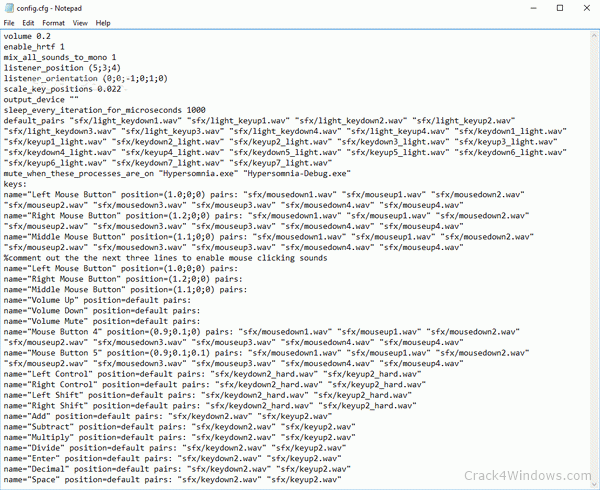May 17th 2017
Mechanical Keyboard Simulator 1.0.8 Crack With Serial Number Latest

Download Mechanical Keyboard Simulator
-
球迷的机械键盘喜欢这些设备在不小的一部分,因为特征的声音,他们产生与每一个按键。 虽然令人讨厌的一些其他人根本无法回到一个隔膜键盘后的使用机械之一。
机械式键盘模拟器是一个轻便的守护程序,使你能够听到这些与众不同的按键的声音,甚至如果您使用的是耳机或必要类型使用非机键盘。 它是一位配置困难,但它的工作,同时运行悄悄的背景。
如果你从来没有使用机械键盘之前,你必须有至少听说过你的一个邻国使用一个。 他们肯定是响亮,但他们更舒适用于输入,和许多实际上喜欢的噪音他们产生。
如果没有其他机键盘模拟器会帮助你找出是否这些设备是给你的。 击键声音捕捉使用的一个实际机械键盘时,并给我留下深刻印象的是通过质量的记录。
一旦你已经启动的程序,你会听见的特点击和水龙头只要你按一个关键。 如果这些听起来是不是你喜欢的,你必须关闭的过程中从任务经理。
有相当多的设置,可以自定义,但是你需要打开的"配置。cfg"的文件,以便执行任何修改。 该配置是相对比较简单和一些解释甚至在网上提供,但这个工具是不完全的新手。
从配置文件中,你可以,例如,改变体积键,启用或禁用HRTF(头有关的传送功能),改变空间位置的听众和选择设备的输出。
模拟器,甚至可以柔和的某些进程和一组可选的鼠标点击的声音,可以启用通过评论了一些线路在配置文件。
击键声都存储在该程序的文件夹果文件,因此它应该很容易替换他们与其他人,你找到更适宜的。
总体而言,机械式键盘模拟器确实非常正是它的名称所暗示的,并可配置到适合你的需要没有太多的努力。 然而,新手肯定会有改变程序的设置使用的一种直观的图形用户界面,更不要说关闭的过程中没有帮助的任务经理。
-
प्रशंसकों के यांत्रिक कीबोर्ड पसंद करते हैं, इन उपकरणों में से कोई छोटा सा भाग में कारण की विशेषता लगता है वे उत्पन्न के साथ हर keystroke. जबकि कष्टप्रद कुछ के लिए, दूसरों को बस नहीं कर सकते करने के लिए वापस जाने के लिए एक झिल्ली कीबोर्ड का उपयोग करने के बाद एक यांत्रिक एक है ।
यांत्रिक कीबोर्ड सिम्युलेटर एक हल्के डेमॉन सक्षम बनाता है कि आप करने के लिए सुनो करने के लिए इन विशिष्ट कीस्ट्रोक लगता है यहां तक कि अगर आप headphones का उपयोग कर या टाइप करने के लिए है एक गैर का उपयोग-यांत्रिक कीबोर्ड है । यह एक मुश्किल सा है विन्यस्त करने के लिए है, लेकिन यह काम करता है चल रहा है, जबकि पृष्ठभूमि में चुपचाप.
यदि आप कभी नहीं किया है एक यांत्रिक कीबोर्ड से पहले, आप होना चाहिए कम से कम एक के बारे में सुना अपने पड़ोसियों में से एक का उपयोग कर. वे कर रहे हैं निश्चित रूप से जोर है, लेकिन वे कर रहे हैं और अधिक आरामदायक टाइपिंग के लिए, और कई वास्तव में शोर की तरह वे उत्पन्न.
यदि और कुछ नहीं, यांत्रिक कीबोर्ड सिम्युलेटर में मदद मिलेगी आप चाहे या नहीं इन उपकरणों के लिए कर रहे हैं आप. कीस्ट्रोक आवाज़ पर कब्जा कर रहे हैं का उपयोग कर एक वास्तविक यांत्रिक कीबोर्ड, और मुझे प्रभावित किया गया था द्वारा रिकॉर्डिंग की गुणवत्ता.
एक बार जब आप शुरू कार्यक्रम के साथ, आप सुना होगा विशेषता क्लिक करता है और नल, जब भी आप एक कुंजी दबाएँ. अगर ये लगता है कि नहीं कर रहे हैं करने के लिए अपनी पसंद के हिसाब से, आप नीचे बंद करने के लिए प्रक्रिया से कार्य प्रबंधक ।
वहाँ काफी कुछ कर रहे हैं कि सेटिंग्स अनुकूलित किया जा सकता है, लेकिन आप की जरूरत है खोलने के लिए "config.cfg" फ़ाइल प्रदर्शन करने के क्रम में किसी भी संशोधन. विन्यास अपेक्षाकृत सीधा कर रहे हैं, और कुछ स्पष्टीकरण भी कर रहे हैं ऑनलाइन उपलब्ध है, लेकिन इस उपयोगिता नहीं है वास्तव में नौसिखिया के अनुकूल है ।
विन्यास फ़ाइल से, आप कर सकते हैं, उदाहरण के लिए, मात्रा में परिवर्तन के कीस्ट्रोक्स के साथ, सक्षम या अक्षम HRTF (सिर से संबंधित हस्तांतरण समारोह) बदलने के लिए, स्थानिक स्थिति के श्रोता का चयन करें और आउटपुट डिवाइस है ।
सिम्युलेटर कर सकते हैं यहां तक कि मौन हो के लिए कुछ प्रक्रियाओं, और एक वैकल्पिक सेट में माउस क्लिक करें, ध्वनियाँ सक्षम किया जा सकता है टिप्पणी के द्वारा बाहर कुछ लाइनों में विन्यास फाइल है ।
कीस्ट्रोक लगता है कर रहे हैं में संग्रहीत कार्यक्रम फ़ोल्डर के रूप में WAV फ़ाइलों, तो यह आसान होना चाहिए उन्हें बदलने के लिए, दूसरों के साथ आप को लगता है कि किया जा करने के लिए अधिक उपयुक्त है ।
कुल मिलाकर, यांत्रिक कीबोर्ड सिम्युलेटर करता है बहुत ज्यादा बिल्कुल क्या इसके नाम से पता चलता है, और यह विन्यस्त किया जा सकता करने के लिए आपकी आवश्यकताओं के अनुरूप बहुत प्रयास के बिना. हालांकि, novices निश्चित रूप से पसंद है बदलने के लिए कार्यक्रम की सेटिंग का उपयोग कर एक सहज ज्ञान युक्त जीयूआई का उल्लेख नहीं है, शट डाउन प्रक्रिया की मदद के बिना कार्य प्रबंधक ।
-
Fans of mechanical keyboards prefer these devices in no small part because of the characteristic sounds they generate with every keystroke. While annoying for some, others simply cannot go back to a membrane keyboard after using a mechanical one.
Mechanical Keyboard Simulator is a lightweight daemon that enables you to listen to these distinctive keystroke sounds even if you are using headphones or have to type using a non-mechanical keyboard. It is a bit difficult to configure, but it does the job while running quietly in the background.
If you have never used a mechanical keyboard before, you must have at least heard one of your neighbors using one. They are certainly loud, but they are much more comfortable for typing, and many actually like the noise they generate.
If nothing else, Mechanical Keyboard Simulator will help you figure out whether or not these devices are for you. The keystroke sounds are captured using an actual mechanical keyboard, and I was impressed by the quality of the recordings.
Once you have launched the program, you will hear the characteristic clicks and taps whenever you press a key. If these sounds are not to your liking, you have to shut down the process from the Task Manager.
There are quite a few settings that can be customized, but you need to open the “config.cfg” file in order to perform any modifications. The configurations are relatively straightforward, and some explanations are even available online, but this utility isn’t exactly novice-friendly.
From the configuration file, you can, for instance, alter the volume of the keystrokes, enable or disable HRTF (Head-Related Transfer Function), change the spatial position of the listener and select the output device.
The simulator can even be muted for certain processes, and an optional set of mouse click sounds can be enabled by commenting out a few lines in the configuration file.
The keystroke sounds are stored in the program folder as WAV files, so it should be easy to replace them with others that you find to be more suitable.
Overall, Mechanical Keyboard Simulator does pretty much exactly what its name suggests, and it can be configured to suit your needs without too much effort. However, novices would certainly have preferred to change the program’s settings using an intuitive GUI, not to mention shut down the process without the help of the Task Manager.
Leave a reply
Your email will not be published. Required fields are marked as *




